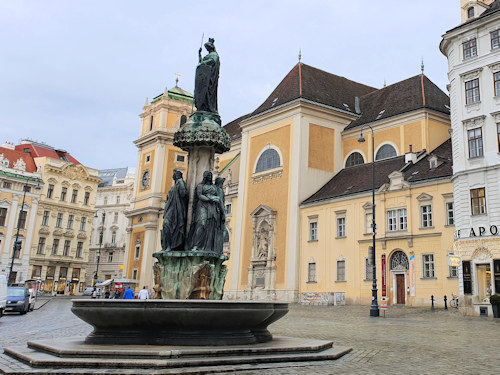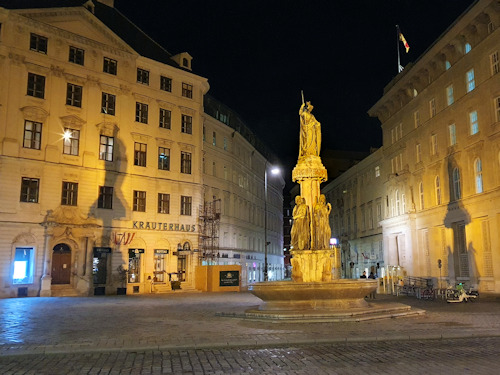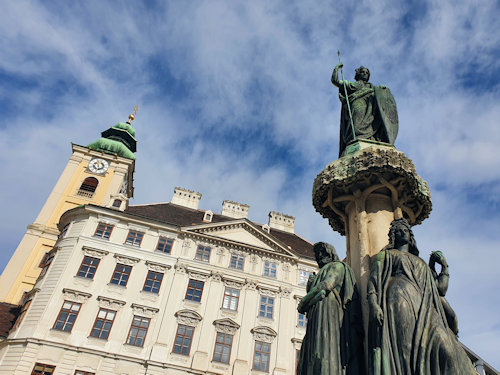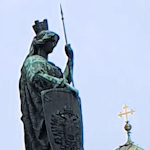I’m not going to lie. The Austriabrunnen on the Freyung square rarely makes an appearance on any tourist top 10 lists. But this small fountain shows how “insignificant” features within a city like Vienna hide so much historical detail.
- Mid-19th century bronze, granite and limestone fountain
- Representations of great rivers hint at the power of the Austrian Empire
- Book a themed guided tour* for your visit
- See other famous Viennese fountains:
Imperial figures and rivers

(The fountain with the Schottenkirche church behind)
Brunnen means fountain in German, which makes translating Austriabrunnen into English relatively easy.
It might seem unimaginative to name something for the country it stands in, but the Austrian Empire was still relatively young at the time.
(Also, the authorities in Vienna have never been reluctant to do a bit of patriotic showboating in bronze and stone.)
Five allegorical figures make up the main part of the fountain, which was first revealed to the public in 1846.

(The fountain casts shadows on historical walls at night)
The top figure is the personification of the empire. Armed with lance and shield, the berobed Austria looks across the square in the direction of the Hofburg (former home to the emperor).
The four figures lower down offer a more intriguing story, however. Each stands for a river.
But not just any old rivers: the Elbe, Danube, Po, and Vistula represent some of Europe’s greatest waterways.
Each river also passed through part of the Austrian Empire at the time, and each discharged its waters into a different sea.

(The fountain photographed by Andreas Groll sometime between 1850 and 1870; Wien Museum Inv.-Nr. 61460; excerpt reproduced with permission under the terms of the CC0 licence)
As such, the Austriabrunnen encapsulated the extent and influence of the Habsburg monarchy:
- The Elbe would have crossed much of the Austrian crown lands of Bohemia on its way to the North Sea
- The Danube passed directly through Vienna and Hungary on its way to the Black Sea
- The Po skirted the southernmost parts of the Austria-ruled Kingdom of Lombardy-Venetia and emerged into the Adriatic Sea below Venice
- On its journey northward to the Baltic Sea, the Vistula marked much of the border of Austria-ruled Galicia with the Kingdom of Poland
The inscription running around the plinth that holds the four river figures reads (my rough translation):
Erected by the citizens of Vienna during the rule of Ferdinand I

(“Austria” sits atop the installation)
The contract for designing the fountain went to Ludwig von Schwanthaler in Munich (outside the empire!), where Ferdinand Miller’s foundry also cast the various bronze figures.
Schwanthaler’s other works include such relatively famous pieces as the Mozart monument in Salzburg (not to be confused with the Vienna equivalent) and the giant Bavaria statue outside Munich’s colonnaded Ruhmeshalle “hall of fame”.
Miller’s work had an even wider impact. He cast, for example, the Columbus doors of the main entrance to the Capitol Building (!) in Washington DC.
The response to the fountain seems to have been positive: the city made Schwanthaler an honorary citizen in 1847 for his watery contribution.
How to get to the Austriabrunnen
The fountain sits in the middle of the Freyung. Follow the link for travel tips and extensive information on the many historical buildings around this square with its intimate ties to a 12th century abbey neighbour.
Address: Freyung, 1010 Vienna
